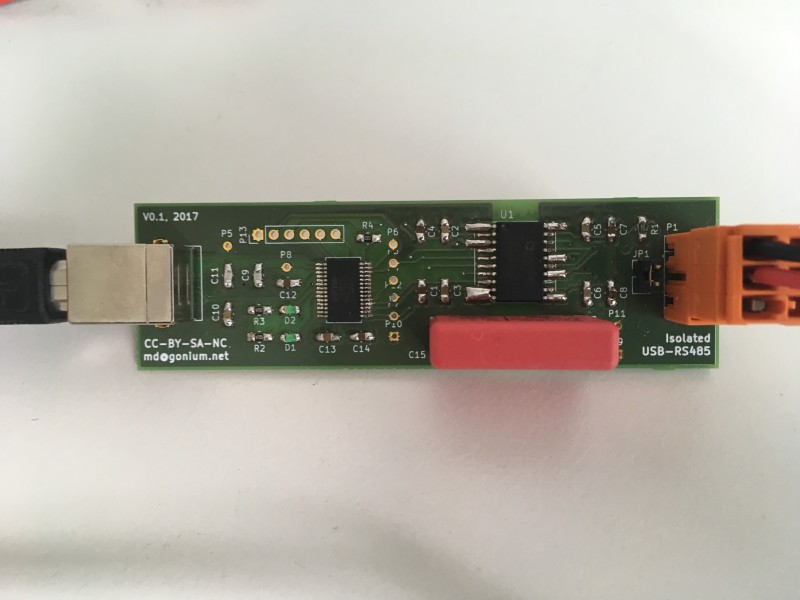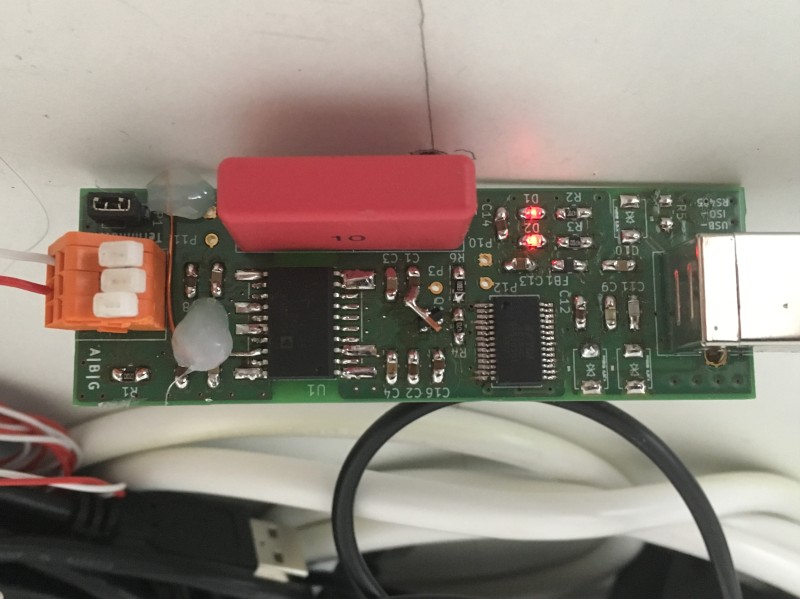I connected a lot of USB-RS485 adapters to my smart meter readout software and wasn't happy. Either the device is cheap and broken or works but is very expensive. The supercheap adaptors from China often provice no ground connection, one worked fine, another one was unstable. Both did not adhere to the USB spec (90mA initial current draw limit). On the other hand, industrial adaptors like the Meilhaus RedCOM USB-COMi-SI or the ADAM 4561 isolate the RS-485 bus from the USB line and work extremely reliable. But they are really expensive.
This project aims to create an adaptor that works well and is reasonably priced. We use the following components:
- An FTDI FT232L provides the USB-UART interface and can be configured for RS485 operation.
- An Analog Devices ADM2582E isolates the RS485 bus and generates the supply voltage for the bus. Please note: this device is rather expensive, but Analog Devices will send you samples at no cost.
- We use WAGO 233 series connectors to connect to the RS485 bus
The first prototype looks like this:
The PCB is too big, and I don't need all those test points any more. Therefore, I have build the second prototype. Please note that the board is slightly smaller, has a different WAGO connector and unpopulated footprints for protection diodes:
The second prototype works quite well. Unfortunately, the holes for the WAGO connector are too small -- I needed to drill them bigger. While doing so, I destroyed a connection to the "A" pin - the copper wire to the right of the WAGO connector replaces the PCB trace I destroyed. In addition, the footprint for the MOSFET is wrong.
Minor layout changes are needed, but the principle is solid.
- Copy all footprints to project library
- Footprint of MOSFET is wrong
- Increase hole diameter for WAGO connector
- Fix position of silkscreen on bottom layer
The FTDI chip needs to be configured in order to work in this application. Specifically, the following changes need to be written into its EEPROM:
- CBUS3 must be set to PwrEN. This ensures that the device draws only 90 mA when plugged in. After completing the USB enumeration process, this pin triggers the onboard MOSFET and the remainder of the board is powered up.
- CBUS4 must be set to TxDEN. The FTDI toggles the nRE pin of the ADM2582.
You can use Mark Lord's ft232r_prog to change the EEPROM settings. In order to see the current EEPROM content, use
$ ft232r_prog --verbose --dump --old-vid 0x0403 --old-pid 0x6001
In order to set CBUS3 to PwrEN, CBUS4 to TxDEN, high-current-io off and the maximum power consumption to 300 mA, use
$ ft232r_prog --verbose --dump --old-vid 0x0403 --old-pid 0x6001 \
--cbus3 PwrEn --cbus4 TxDEN --high-current-io off --max-bus-power 300
On Linux I could successfully compile the binary just by typing
make and using it as described above. On Mac OS X, I needed to add
/usr/local to the Makefile. The top two lines now read like this:
CFLAGS = -Wall -O2 -s -Werror -I/usr/local/include
LDFLAGS = -L/usr/local/lib -lusb -lftdi -s
In my case, a FTDI driver claimed the device, preventing the
ft232r_prog command to communicate with the FTDI. You can list the
FTDI-related kernel extensions using
$ kextstat | grep FTDI
156 0 0xffffff7f83606000 0x8000 0x8000 com.FTDI.driver.FTDIUSBSerialDriver (2.2.16) 0AB01558-B114-9EF2-1CD9-A13CFA557737 <137 55 5 4 3 1>
Then, to unload the driver, use
$ sudo kextunload -b com.FTDI.driver.FTDIUSBSerialDriver
for all FTDI drivers you found.

